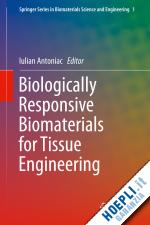

Questo prodotto usufruisce delle SPEDIZIONI GRATIS
selezionando l'opzione Corriere Veloce in fase di ordine.
Pagabile anche con Carta della cultura giovani e del merito, 18App Bonus Cultura e Carta del Docente
Developments in the area of biomaterials, bionanotechnology, tissue engineering, and medical devices are becoming the core of health care. Almost all medical specialties involve the use of biomaterials, and research plays a key role in the development of new and improved treatment modalities. This volume focuses on several current trends in tissue engineering, remodelling and regeneration. Leading researchers describe the use of nanomaterials to create new functionalities when interfaced with biological molecules or structures. In addition to coverage of basic science and engineering aspects, a range of applications in bionanotechnology are presented, including diagnostic devices, contrast agents, analytical tools, physical therapy applications, and vehicles for targeted drug delivery. The use of polymers, alloys, and composites, or a combination of these, for biomaterials applications in orthopaedics is also explored. These contributions represent essential reading for the biomaterials and biomedical engineering communities, and can serve as instructional course lectures targeted at graduate and post-graduate students.
Preface.- Chapter 1 Scaffold Design For Bone Tissue Engineering: From Micrometric To Nanometric Level.- Chapter 2 Molecular Scissors - from Biomaterials Implant to Tissue Remodeling.- Chapter 3 Synthetic Morphogens and Pro-morphogens for Aided Tissue Regeneration.- Chapter 4 The role of oxidative stress in the response of endothelial cells to metals.- Chapter 5 Comparative properties of ethyl, n-butyl and n-octyl cyanoacrylate bioadhesives intended for wound closure.- Chapter 6 Development of bioabsorbable interference screws – how influence biomaterials composition, clinical and retrieval studies the innovative screw design and manufacturing processes.- Chapter 7 Modeling And Numerical Analysis Of A Cervical Spine Unit.- Chapter 8 Carbon Nanotubes in Acrylic Bone Cement.- Chapter 9 Exploring the future of hydrogels in rapid prototyping: a review on current trends and limitations.











Il sito utilizza cookie ed altri strumenti di tracciamento che raccolgono informazioni dal dispositivo dell’utente. Oltre ai cookie tecnici ed analitici aggregati, strettamente necessari per il funzionamento di questo sito web, previo consenso dell’utente possono essere installati cookie di profilazione e marketing e cookie dei social media. Cliccando su “Accetto tutti i cookie” saranno attivate tutte le categorie di cookie. Per accettare solo deterninate categorie di cookie, cliccare invece su “Impostazioni cookie”. Chiudendo il banner o continuando a navigare saranno installati solo cookie tecnici. Per maggiori dettagli, consultare la Cookie Policy.